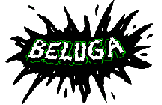| Beluga Monitoring at Nastapoka |
| The Inuit hunters of Inukjuaq traditionaly hunt at Nastapoka. This particular year they captured approximatly 19 beluga. I believe they excceded there agreed upon quota. The year after this an underwater sound study will be conducted to better understand the sound dynamics produced by the adjacent islands. Is motor traffic amplified by the islands? Does the echo interfere with beluga's natural sonor system? These are a number of questions that remain to be answered. And hopefully future studies will be carried out to help clear these questions up |
| Beluga skin (muktuq) is considered a delicacy to Inuit. As seen above none of the beluga is gone to waste. One of the major problems in beluga mangement is that nunavik communities are growing faster then beluga populations. There will not be enough beluga to satisfy the desire for muktuq unless careful mangement practices are put into action. |
 |
| Lately beluga numbers have been reportely decreaseing according to the Dept. of Fisheries and Oceans. The Inuit on the Hudson coast presume that the numbers are inacurrate and that increasing boat traffic is the cause for the appearence of lower numbers of beluga. Makivik who looks out for the interest of Inuit is looking into this possiblity by monitoring the appearence of whales and boat traffic. |
 |
| Above: Camp at Nastapoka falls. It is belived that beluga enter the estuary to shed thier skin in the warm waters. This fact may prove important in discouraging Hydro Quebec to choose this river system for damming. |
| The Inukjuaq hunters where kind enough to allow Makivik Research staff to collect beluga bio data and samples. This was a great oppurtunity since whale samples are rare anywhere in the world. The samples where to be tested for contaminats both by Makivik and Simon Fraser University. Endocrine samples were also taken to investigate the odd "pock marks" seen on Hudson Beluga. |